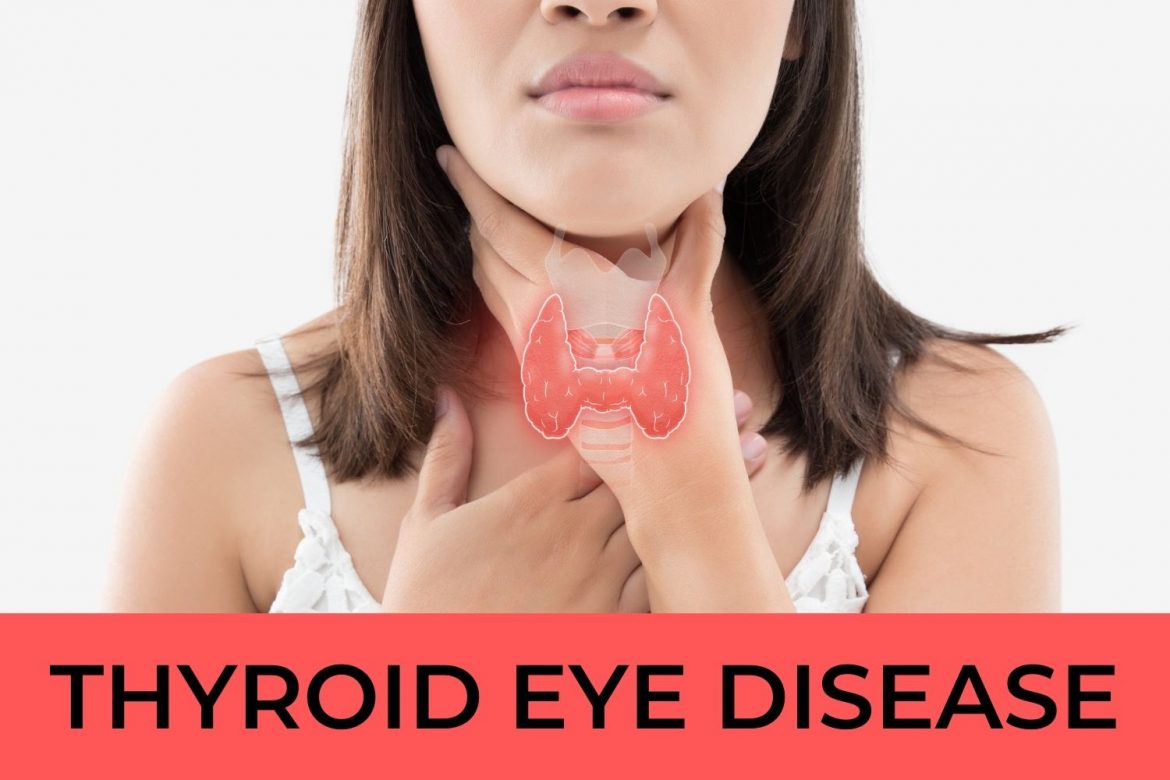![]()
An estimated one out of every 100 Americans is affected by a condition known as Graves’ disease. Graves’ disease is an autoimmune disease that leads to an overactive thyroid, a condition more commonly known as hyperthyroidism. Those diagnosed with Graves’ disease are also at an increased risk of developing Graves’ ophthalmopathy, also known as thyroid eye disease (TED).
In fact, it’s estimated that one out of every four people with Graves’ disease will experience some form of TED. In addition, and according to the National Organization for Rare Disorders (NORD), TED is five times more common in women but more likely to be more severe in men.
For most, symptoms of TED usually appear within six months of the appearance of symptoms associated with Graves’ disease.
What causes thyroid eye disease?
Graves’ disease causes antibodies found within your body to attack the thyroid, a small butterfly-shaped gland found at the base of your neck. As a result, the thyroid, in its defense against this attack, releases cytokines, a substance that produces inflammation throughout the body.
While the exact connection between hyperthyroidism and TED is not yet known, scientists believe it is most likely the result of the body’s immune system, and specifically the cytokines targeting the healthy tissues in and around the eye.
This abnormal immune response most often results in inflammation occurring in several parts of the eye as well as in the muscle and fat located around and behind the eye. This inflammation in and around the eye contributes to a host of symptoms that are most commonly associated with TED.
Symptoms of thyroid eye disease
The initial symptoms of TED often resemble symptoms commonly associated with a wide range of eye health conditions and often include watery or dry eyes and a feeling of grittiness in the eyes. Considering this, it’s not surprising to learn TED is often initially misdiagnosed as either allergies or an eye infection.
TED is also considered to be a heterogeneous condition, meaning the symptoms tend to differ from patient to patient.
While the symptoms of TED can vary, they generally tend to involve one or more of the following:
- Itching
- Dry eyes
- Redness
- Orbital pain or pressure
- Double vision
- Sensitivity to light
- Swelling around the eye
In addition, since TED attacks the healthy tissues in and around the eye, it is common for those with the condition to experience a more significant symptom known as exophthalmos, the medical term for bulging or protruding eyeballs.
TED can cause the muscles in your eyelids to tighten and contract, resulting in the upper eyelid drawing up and the lower eyelid being pulled down. At the same time, there can also be swelling occurring on the front portion of the eyeball. The combination of these symptoms results in a larger than normal portion of the whites of the eyes showing, creating the perception that the eyes are “bulging” out of their sockets.
How thyroid eye disease is diagnosed
In most cases, TED is diagnosed in conjunction with Graves’ disease, which is typically diagnosed by using a simple blood test known as a thyroid function test.
In cases where the thyroid function test is inconclusive, doctors might also recommend a series of additional tests, including a CT scan or MRI to examine swelling, or a series of tests to assess the field of vision, eye pressure, color vision, and optic nerve health.
Treating this condition
There are several options to help treat and manage thyroid eye disease. One of the most important first steps to treating TED is not to see your eye doctor, but rather your endocrinologist. Your endocrinologist will help you manage your thyroid, ensuring your thyroid hormones, including thyroxine, triiodothyronine, a thyroid-stimulating hormone are kept within normal limits.
In addition to working with your endocrinologist to manage your thyroid-related hormone levels, research published in Clinical Endocrinology demonstrates that increasing your intake of the mineral selenium helps decrease the progression of TED in those experiencing it with mild-to-moderate symptoms. One of the easiest ways to increase your intake of selenium is to eat Brazil nuts, which are naturally rich in the mineral.
Other common ways to treat or manage the symptoms of TED include:
- Using lubricating eye drops, such as artificial tears, to alleviate dry and itchy eyes
- Wearing sunglasses to reduce discomfort associated with sensitivity to light
- Prescription-strength prism glasses to ease the effects of TED-related double vision
In the case of moderate to severe thyroid eye disease, your doctor might also prescribe steroids or other anti-inflammatory medications in order to reduce swelling and inflammation in and around your eyes.
Doctors will typically use the treatment methods mentioned above during the active or inflammatory stage of TED, which usually corresponds with the first three years of the disease.
Severe cases of TED that are not responsive to traditional treatment options could require more invasive treatment procedures, including an eye infusion specifically designed to prevent inflammation and TED-related eye-bulging, surgical procedures to correct the positioning of the eye and eyelids, or treatment with radiation to reduce inflamed tissue in and around the eye socket.
Living with this condition
For some, the symptoms associated with thyroid eye disease will go away on their own and without treatment. For others, the condition will require a combination of monitoring and treatment by both your endocrinologist and your eye doctor.
If you’ve recently been diagnosed with Graves’ disease or have been experiencing any of the TED-related symptoms mentioned above, specifically optical pressure or bulging eyes, be sure to schedule an appointment with your endocrinologist and your eye doctor to talk about a treatment plan that works for you.
Fortunately, with the proper treatment, the symptoms of TED are able to be well managed, and those diagnosed with the condition are able to live a normal life with minimal disruption resulting from thyroid eye disease.


